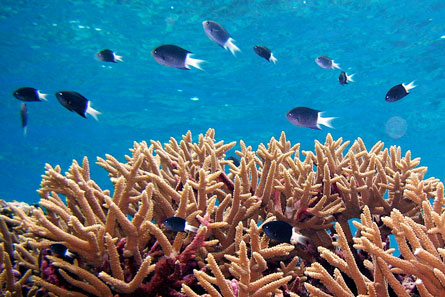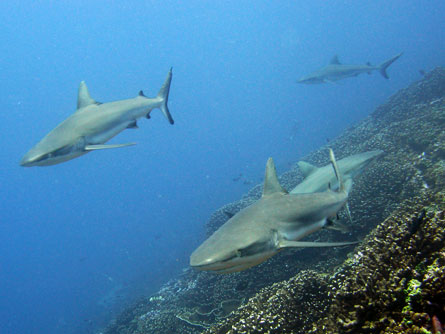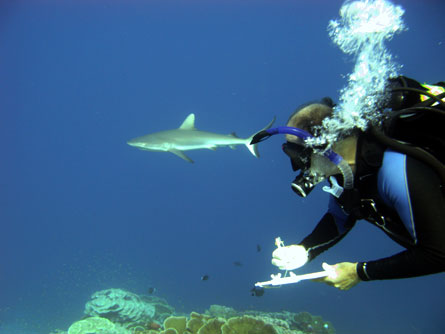Giving sharks safe homes
Scientists help to understand and protect sharks and coral reefs
By Mark Schrope
 |
|
Small bicolor damselfish swim above a patch of Acropora coral in the Line Islands.
|
| Kevin Lafferty/USGS |
Being surrounded by sharks may sound like a bad thing. But scientists say sharks are actually a good sign of ocean health. Even knowing that, Enric Sala was a little nervous when he first dived at Kingman Reef. It’s the heart of a massive, newly protected area south of Hawaii now called the Pacific Remote Islands Marine National Monument.
“The first time I jumped in the water, as soon as the bubbles cleared, my heartbeat doubled,” recalls the marine ecologist and National Geographic Fellow. “There were a dozen sharks swimming around us and so many corals on the bottom that there was not even space for sand between them,” says Sala.
He led a series of expeditions to the region’s coral reefs over the past several years. It was part of his work at the Scripps Institution of Oceanography in La Jolla, Calif. His team’s findings about sharks and corals there helped inspire the U.S. government to set up the new monument, where fishing for sharks or anything else is now forbidden.
Groups around the world are working to set up other huge protected ocean areas in hopes of saving some of the planet’s most incredible and important spots.
just before he left office in January, President George W. Bush set up another new marine reserve, or protected area. This one is called the Pacific Remote Islands Marine National Monument. It includes waters around several groups of islands near Kingman Reef, which is 1,000 miles south of Hawaii. This new monument covers 86,888 square miles. That’s bigger than the size of Virginia and Tennessee combined.
Remote means distant. And that’s definitely a good description of this area. Very few people have ever visited here, much less lived here. That remoteness is exactly why Sala and the many scientists he works with find so many sharks on their dives.
It’s also why they went there in the first place. At almost all of the other coral reefs on the planet, pollution and activities such as fishing have caused so much harm that it’s difficult to figure out what they used to look like. Fishing is especially a problem for animals such as sharks, which are top predators. That means they eat lots of animals, but hardly ever get eaten themselves (except when humans catch them).
 |
|
Gray reef sharks swimming over a live coral reef in the Pacific Ocean’s Line Islands.
|
| Stuart Sandin |
Shark fins are used in an expensive soup that is popular in many Asian countries, meaning fishermen can make a lot of money selling fins. That’s a big problem, because the top predators also grow very slowly, and if they get caught faster than their babies can grow up, groups of them, or even whole species, can be lost.
Researchers estimate that about 90 percent of the ocean’s top predators have been lost in recent decades because of fishing, and many shark species are so overfished they are in danger of extinction. Though there hasn’t been much fishing in the Pacific Remote Islands Monument region, researchers pushed for its protection to help keep major fishing from ever starting there.
Sala and other scientists, such as Stuart Sandin of the Scripps Institution of Oceanography, began studying Kingman Reef and other nearby areas because they thought the reefs would be especially healthy. And that’s exactly what they’ve found on expeditions over the past five years. The number of sharks is a key part of that. After all, sharks are essential for healthy reefs. They eat the weaker and older adult fish, which guarantees that the remaining fish are healthy and fit.
“The more time we spend out there, the more we realize this is how a coral reef should feel,” says Sandin. He too was surrounded by sharks the fist time he dived in the region. But even more memorable, he says, was diving at a reef with a very strong current and drifting with 15 grey reef sharks swimming between him and his dive partners. Those sharks “were enjoying the current as much as we were,” says Sandin, who compares sharks to playful dogs. As surprising as the sharks have been on dives, they’ve turned out to be an even bigger scientific surprise, and something of a puzzle.
Ecologists study how animals and other organisms relate to each other. Whether working on land or in the ocean, ecologists usually expect to find lots and lots of smaller animals and only a few top predators. That seems logical enough, because it takes lots of the little things to keep the bigger things fed.
But Sala’s team found just the opposite at Kingman. In fact, large predators make up 80 percent of the total weight of animals on the reef. And about half of that is sharks. In other words, if sharks were acting like the man-eaters that many people think they are, instead of like playful dogs, the scientists would have been in trouble on their dives.
 |
|
Scientist Alan Friedlander of the U.S. Geological Survey takes notes while a gray reef shark in the background.
|
| Stuart Sandin |
The scientists are still working to figure out how there can be so many top predators. But they think that the smaller fish grow up especially fast. So even if there aren’t that many of the smaller fish around at one time, there are enough growing up over time to keep the long-lived top predators fed.
If their theory proves correct, scientists will have to rethink some ideas about what a truly healthy coral reef looks like. Being able to learn lessons like that is a big part of why scientists say we need more protected ocean areas where fishing isn’t allowed. About 6 percent of the land on Earth is set aside as reserves where people can’t kill the animals there, but only less than one tenth of one percent of the ocean has similar protection.
Sandin says that healthy reefs like Kingman can be used like “user’s manuals”, because better understanding the healthiest reefs will help scientists to figure out what reefs are supposed to look like. That will help them figure out the best ways to protect and save reefs that aren’t as healthy, such as those in Florida and Hawaii.
Protecting large ocean areas can also help some fish species that are in trouble because of overfishing. Many fish like tuna and sharks travel long distances, so protected areas can act like nurseries where they are safe to grow up and then move out from there into other regions, making those fish populations healthier too.
Right now, Australia is considering establishing the world’s largest marine reserve in the Coral Sea, an area filled with sharks, whales, swordfish, and countless other species. “The Coral Sea has great potential to really make a difference and be a significant contribution to the world’s oceans,” says Heather Bradner, with the Pew Foundation’s Global Ocean Legacy Program, which is helping set up reserves around the globe.
Sala says that such work is essential. “It’s important to have these places,” he says, “so that everybody understands what’s necessary to keep a healthy ocean for us to enjoy.”







